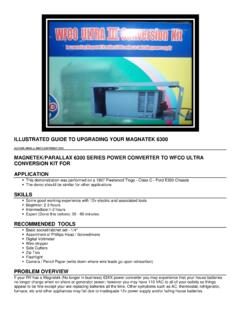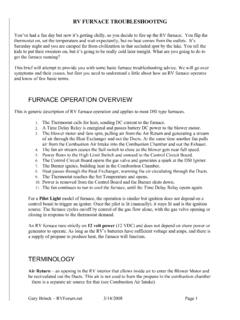Transcription of Motorhome Handling Problems & Solutions A Primer by Gary ...
1 Motorhome Handling Problems & Solutions A Primer by Gary Brinck Motorhome Handling is a complex issue and is often perceived differently by different drivers. Each Motorhome chassis manufacturer makes multiple versions of the same chassis , with different wheelbases and different GVWRs, so one cannot simply compare Freightliner to Spartan or Workhorse to ford . Furthermore, the chassis manufacturers cannot control the weight distribution after the various coach manufacturers add the Motorhome body to the chassis , nor can they predict how the owner will load his gear aboard. This results in an almost infinite variety of Motorhome Handling characteristics, even within the same chassis type or coach model.
2 Because of the variety of Motorhome Handling Problems and unfamiliarity with the terminology, most drivers don't know how to describe their Handling problem or what sort of fix to ask for. "Doesn't handle worth a darn" or wanders all over the road is the usual complaint and "Make it better" the requested action. The average RV shop often isn't any more knowledgeable and generally recommends a one-size-fits-all solution, which varies according to the shop or even which service advisor on duty. One will always say "stiffer shocks" while another always recommends a steering damper, with the result that Motorhome owners usually end up buying add-on parts until they finally hit on the one that addresses their particular problem.
3 This is also the reason why one owner will swear that a particular Handling device is wonderful and another will call it a worthless (but expensive) piece of scrap iron. Each of them had a different problem, on a different rig, caused by different circumstances. Armed with the knowledge of Handling Problems that you will learn about here, hopefully you will be able to more quickly - and less expensively - zero on the right solution for your problem. Weight & Wheelbase Weight distribution has a major effect on the vehicle center of gravity [VCG] and VCG in turn is a major factor in Handling on a large, heavy vehicle.
4 Motorhome Handling improves dramatically as the VCG moves down [lower] and toward the center of the axles, both side to side and fore and aft. Another major and related factor is the length of wheelbase relative to the overall length of the coach. Wheelbase is simple the distance between the front and rear axles. In the case of tandem rear axles (drive axle + tag axle), the rear axle is considered to be at an imaginary point midway between the two. A longer wheelbase generally places the VCG more between the axles rather than toward either end. A rule of thumb is that the wheelbase should be more than 50% of the overall length, with 53% or more deemed to be "good".
5 Because there are so many factors in good Handling , it cannot categorically stated that a wheelbase ratio under 53% will result in poor Handling , but all experts seem to agree that "more is better". Weight & Tire pressure Weighing your Motorhome is the preliminary step in diagnosing nearly all Handling Problems . Besides, you must have accurate weights to correctly inflate the tires, another factor in proper Handling as well as for tire safety. Weigh the Motorhome front and rear axles separately and if possible also get the weights on individual wheels. If you can get the weight for each axle, front and rear, and for one side, you can calculate the weights on each wheel closely enough for most purposes.
6 Get the tire manufacturer's inflation table for your brand of tire. This will tell you how much pressure (psi) is needed in the tire to support a given amount of weight. Use that pressure, plus a safety margin of 5-10 psi, as the pressure in the tires. All the tires on one axle should be inflated the same, so use the weight on the heaviest side to determine the tire pressure for that axle. Front, rear and tag axles can have a different pressure. Alignment Wheel alignment is another important step in good Motorhome Handling . Alignment consists of three measurements, toe, caster and camber.
7 Toe is the inward or outward angle of the wheels with respect to straight ahead. Caster is the tilt of the wheel in the vertical plane, normally angled slightly so that the steering tends to self-center when the vehicle is moving forward. Camber refers to the side-to-side tilt of the wheel, how perpendicular it is to the road. Each chassis will have detailed specs for these three things and it is crucial that they all be as close as possible to dead center on the target numbers. Sometimes each item will be within the tolerances for that spec, but the combined effect of all three being slightly off target can cause the whole coach to steer poorly.
8 Alignment can also change as weight is added or moved around in the coach, so try to have it aligned as you expect to drive it. The coach is aligned at the factory, but it is empty then and things can change after it is loaded for travel. Worn suspension Sloppy fitting mechanical parts in the steering mechanism can also cause fidget steering because a sloppy fit allows the two front wheels to wander even when the steering wheel is held straight. Sloppy fit is a result of wear or sometimes just excessive tolerance in manufacturing. Each part is manufactured to a specification which allows a certain amount of variation, plus or minus, in the size.
9 If too many of the steering parts are at the extreme of their size tolerance, the accumulated tolerance of multiple parts can result in steering which feels loose and requires constant correction. If you are having steering Problems , make sure your front suspension is aligned as close as possible to its "dead center" specifications. If the problem persists, have a skilled mechanic check the tolerances on the steering system components. One common source of sloppy steering is a part of the steering known as the bell crank, which translates the turning of the steering wheel into side-to-side motion of the front wheels.
10 One particular brand of bell crank was widely used in Chevrolet P30 and older Freightliner chassis with a solid axle. It was notorious for poor manufacturing tolerances and quick wear, leading to numerous complaints about steering. A high quality replacement bell crank was designed and manufactured under the Supersteer brand name and is highly recommended if you have one of these chassis . The inferior bell crank was used in new production up until about 1998 or early 1999. Pitching, Porpoising & Roll Coaches with a long rear overhang and/or heavily loaded in the rear ( generators, air conditioners, water tanks or rear engine) will have a tendency to teeter-totter around the rear axle in the vertical direction, resulting in a fore and aft plunging movement called pitching.



